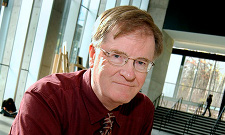
From John Percy, Editor, JAAVSO:
Hidden deep within the AAVSO website is a gold mine -- actually, several gold mines, but the one that I am writing about is JAAVSO: the Journal of the AAVSO. It contains the most precious commodity of the 21st century -- information. Information is magical. I'm thinking of Galileo's tribute to the inventor of the alphabet, "the sublime mind ... who realized that, with twenty characters upon a page, we could communicate across mighty barriers of time and place. That, with a few drops of ink, we could share our deepest thoughts, our most important ideas, and our most profound creations, with those who are not yet born, and will not be born for another thousand years". And the JAAVSO is "open access" -- available to all.
"Open access" is the latest trend in scientific publishing. Governments which fund scientific research are promoting it because it makes the results of that research available to all. Literally hundreds of new open-access journals have been created, mostly by commercial publishers. Who pays the costs? The authors, either from their research grants or their pockets. After all, the academic world is "publish or perish", isn't it? This system, of course, is unfair to authors who do not have research grants -- students, retirees, amateur scientists etc. Commercial publishers obviously want to increase their revenue. They can do this by accepting as many manuscripts as possible. So the standards are not always high. In a recent experiment, Science magazine's John Bohannon submitted bogus research papers to several hundred open access journals. The papers were written with such obvious flaws that they should have been rejected outright by the editors and referees of any reputable journal. In fact, more than half of the journals accepted the papers (Bohannon 2013). So much for quality control! The JAAVSO maintains its quality control through its system of editors and volunteer referees, as I explained in my Editorial message in JAAVSO volume 41, number 2.
But someone has to pay the costs of open-access journals. Who pays for the JAAVSO? The AAVSO does, as a service to you, the readers, members, observers, students, other hangers-on, and the astronomical community at large. It is AAVSO's mission to "discover the universe through variable stars". JAAVSO shows how we are doing it!
JAAVSO is open-access in another respect: we accept manuscripts from any amateur or professional astronomer or student, as long as the content is relevant and significant (and correct!), and the presentation is clear and concise. Full instructions are given in How to Submit an Article to the JAAVSO. There are also notes from a workshop on scientific publication at this URL. And look at a current JAAVSO volume for concrete examples of how manuscripts should look. Our referees and editors will assess the manuscripts for relevance, correctness, and presentation, and give you feedback, and the JAAVSO staff -- Michael Saladyga, Matthew Templeton, and Elizabeth Waagen -- will edit the manuscript into "house style".
The subject of your manuscript should be variable stars or a closely-related topic. That's quite broad, as you can see from any recent issue, especially the Centennial Issue, volume 40 number 1 (2012). It can be about observation, analysis, techniques, instrumentation, education, history etc. One of the things that I like about astronomy, and amateur astronomy, and the AAVSO is its breadth, and its connections to other aspects of science, technology, and culture. After all, multiperiodic pulsating stars are sometimes described as "the music of the spheres"! And scientific communication, to audiences such as JAAVSO's, is an art in itself. So get your creative juices flowing! Contribute to JAAVSO!

